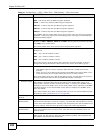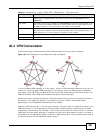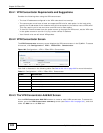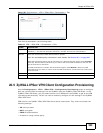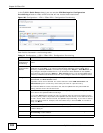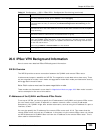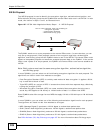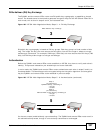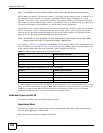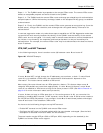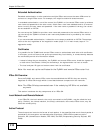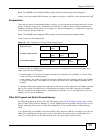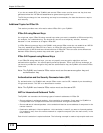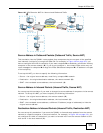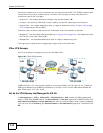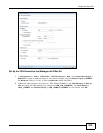
Chapter 20 IPSec VPN
ZyWALL 110/310/1100 Series User’s Guide
308
Note: The ZyWALL and the remote IPSec router must use the same pre-shared key.
Router identity consists of ID type and content. The ID type can be domain name, IP address, or e-
mail address, and the content is a (properly-formatted) domain name, IP address, or e-mail
address. The content is only used for identification. Any domain name or e-mail address that you
enter does not have to actually exist. Similarly, any domain name or IP address that you enter does
not have to correspond to the ZyWALL’s or remote IPSec router’s properties.
The ZyWALL and the remote IPSec router have their own identities, so both of them must store two
sets of information, one for themselves and one for the other router. Local ID type and content
refers to the ID type and content that applies to the router itself, and peer ID type and content
refers to the ID type and content that applies to the other router.
Note: The ZyWALL’s local and peer ID type and content must match the remote IPSec
router’s peer and local ID type and content, respectively.
For example, in Table 114 on page 308, the ZyWALL and the remote IPSec router authenticate each
other successfully. In contrast, in Table 115 on page 308, the ZyWALL and the remote IPSec router
cannot authenticate each other and, therefore, cannot establish an IKE SA.
It is also possible to configure the ZyWALL to ignore the identity of the remote IPSec router. In this
case, you usually set the peer ID type to Any. This is less secure, so you should only use this if your
ZyWALL provides another way to check the identity of the remote IPSec router (for example,
extended authentication) or if you are troubleshooting a VPN tunnel.
Additional Topics for IKE SA
This section provides more information about IKE SA.
Negotiation Mode
There are two negotiation modes--main mode and aggressive mode. Main mode provides better
security, while aggressive mode is faster.
Main mode takes six steps to establish an IKE SA.
Table 114 VPN Example: Matching ID Type and Content
ZYWALL REMOTE IPSEC ROUTER
Local ID type: E-mail Local ID type: IP
Local ID content: tom@yourcompany.com Local ID content: 1.1.1.2
Peer ID type: IP Peer ID type: E-mail
Peer ID content: 1.1.1.2 Peer ID content: tom@yourcompany.com
Table 115 VPN Example: Mismatching ID Type and Content
ZYWALL REMOTE IPSEC ROUTER
Local ID type: E-mail Local ID type: IP
Local ID content: tom@yourcompany.com Local ID content: 1.1.1.2
Peer ID type: IP Peer ID type: E-mail
Peer ID content: 1.1.1.20 Peer ID content: tom@yourcompany.com



